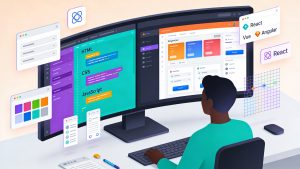The technology landscape offers a variety of career paths, with Data Scientist and Full-Stack Developer standing out as two of the most dynamic and sought-after roles. While both positions are integral to modern businesses, they demand unique skill sets, responsibilities, and mindsets. This guide provides an in-depth comparison to help aspiring professionals choose the path that aligns with their interests and strengths.
Data Scientist: Role and Responsibilities
A data scientist specializes in extracting meaningful insights from complex datasets using statistical, computational, and analytical techniques. Their primary focus is to interpret and communicate data-driven stories that inform business decisions.
Core responsibilities include:
- Analyzing large datasets to identify trends and patterns
- Building predictive models and algorithms using machine learning
- Preparing and cleaning raw data for analysis
- Leveraging tools such as Python, R, SQL, Tableau, and Power BI for data analysis and visualization
- Presenting findings and recommendations to stakeholders through reports and dashboards
Full-Stack Developer: Role and Responsibilities
A full-stack developer is a versatile software engineer capable of managing both the front-end and back-end aspects of web applications. This dual expertise allows them to oversee projects from user interface design to server-side logic and database management.
Key responsibilities involve:
- Designing and developing complete web applications
- Creating interactive user interfaces with HTML, CSS, JavaScript, and frameworks like React or Angular
- Implementing server-side code using languages such as Python, Java, PHP, or Node.js, and managing databases like MySQL or MongoDB
- Testing, debugging, and ensuring seamless integration between front-end and back-end components
- Collaborating with designers, product managers, and QA teams to deliver robust features
Required Technical Skills and Tools
Data Scientist
- Programming Languages: Python, R, SQL, SAS, Scala
- Statistical & ML Libraries: scikit-learn, TensorFlow, pandas, NumPy
- Data Wrangling & Storage: Pandas, Hadoop, Spark, HDFS
- Visualization Tools: Tableau, Power BI, matplotlib, seaborn
- Domain Knowledge: Statistics, probability, and industry-specific expertise
Full-Stack Developer
- Front-End Technologies: HTML, CSS, JavaScript, React, Angular, Vue.js
- Back-End Technologies: Node.js, Python (Django/Flask), Java (Spring), PHP
- Database Management: MySQL, PostgreSQL, SQL Server, MongoDB, Cassandra
- Development Tools: Git, package managers, build tools, Docker, DevOps basics
- UX/UI Principles: Understanding of user interface design for effective collaboration
In essence, data scientists focus on data analysis and predictive modeling, while full-stack developers excel in software engineering across the entire web stack.
Educational and Learning Paths
Data Scientist
- Often begins with a degree in computer science, statistics, engineering, or a related field
- Approximately half hold a bachelor’s degree, and a significant number have a master’s or higher
- Advanced degrees are common in research-focused roles, but alternative routes such as online courses, bootcamps, and professional certificates are increasingly popular
- Building a portfolio through projects, competitions, and capstone assignments is highly recommended
Full-Stack Developer
- Many possess a degree in computer science or software engineering, though self-taught developers and bootcamp graduates are common
- Education emphasizes computer science fundamentals and practical coding experience
- Online platforms and intensive bootcamps provide pathways to learn both front-end and back-end frameworks
- A strong portfolio of web projects is essential for showcasing skills to potential employers
Continuous learning is crucial in both fields, whether it means mastering new machine learning techniques or keeping up with evolving software frameworks.
Career Opportunities and Industry Demand
Data Science
- Vital across industries such as technology, finance, healthcare, and retail
- Roles include Data Scientist, Machine Learning Engineer, Data Engineer, and Business Intelligence Analyst
- High demand due to the growing need for analytics and AI-driven strategies
- Projected job growth of approximately 36% for data scientists from 2023 to 2033, significantly above the average for all occupations
Full-Stack Development
- Highly valued for versatility in startups and established companies alike
- Opportunities span web and mobile application development across industries
- Projected job growth of about 17% for software developers (including full-stack) from 2023 to 2033, indicating steady demand
Both career paths offer robust opportunities, with data science often appealing to those interested in analytics and decision-making, and full-stack development attracting those who enjoy coding and building applications.
Salary and Job Outlook
| Experience Level | Data Scientist (LPA) | Full-Stack Developer (LPA) |
|---|---|---|
| Entry (0–2 yrs) | 5–8 | 4–7 |
| Mid (3–6 yrs) | 10–18 | 8–15 |
| Senior (7+ yrs) | 20–35+ (up to 50+) | 13–30+ |
- Data scientists typically command higher starting salaries, especially in major tech hubs or specialized roles.
- Full-stack developers’ salaries can rise significantly with experience, especially in large tech firms or startups.
- Both roles offer strong compensation and long-term growth potential.
Work Culture and Collaboration
Data Scientist
- Frequently works in interdisciplinary teams with business stakeholders and engineers
- Project-based, research-driven environment requiring analytical thinking and problem-solving
- Flexibility in work arrangements, though deadlines around product launches or business decisions can be demanding
Full-Stack Developer
- Functions within software teams using agile or Scrum methodologies
- Emphasizes teamwork, adaptability, and continuous learning
- Regular coding cycles, code reviews, and collaborative development
- Generally stable work-life balance, with occasional overtime before major releases
Which Path Fits You?
Consider these preferences:
- Enjoys uncovering insights from data and solving analytical problems → Data Scientist
- Prefers building features, user interfaces, and end-to-end applications → Full-Stack Developer
- Fascinated by machine learning, statistics, and AI → Data Scientist
- Excited by web technologies, JavaScript frameworks, and programming → Full-Stack Developer
- Likes presenting findings through reports and dashboards → Data Scientist
- Enjoys seeing a product come to life through code → Full-Stack Developer
Those who align more with data analysis and modeling may find fulfillment in data science, while those who are passionate about software engineering and application development may thrive as full-stack developers. Many skills overlap, and both paths require dedication and a willingness to learn.
Real-World Impact
Both roles are essential in today’s digital world. For example, in a ride-sharing app, full-stack developers build the platform’s infrastructure and user experience, while data scientists analyze user data to optimize pricing and suggest efficient routes. Their collaboration ensures seamless products and innovative solutions.
Conclusion
Data Scientists and Full-Stack Developers both enjoy strong career prospects and play pivotal roles in technology. While their day-to-day work and required skills differ, both careers demand a commitment to continual learning, collaboration, and technical excellence. By building a strong portfolio and choosing the field that excites you most, a rewarding and impactful future in tech awaits.
Read more such articles from our Newsletter here.



